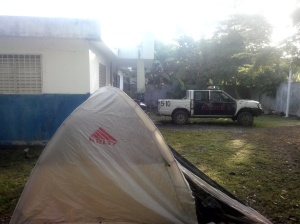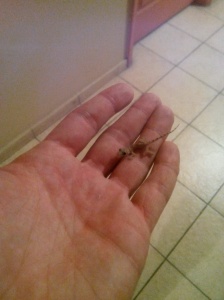I visited a friend in the Sant Lakay of Mouvman Peyizan Papay, a sort of Marxist training center and sustainable agriculture demonstration site. They have some sustainable technology I really like. They keep their goats confined – the only time I have seen this in Haiti. This stops them wreaking havoc, eating baby trees and your gran’s cabbage patch, and also allows their manure to be harvested. They have aquaculture, agroforestry, home gardens, and the best design of composting toilet I’ve seen (and I’ve seen a lot of designs of composting toilet).
This center is five or six kilometers outside of Hinche. I set out from there around 9:30 this morning, and got to Dondon at about 6 in the evening. In between was a rainstorm, a flat tyre, three rivers to ford, an issue with the front axle, an exciting rope bridge, and precious little tarmac (asphalt for those of the Yankee imperialist persuasion).
Papaye, to Hinche, to Maïcasse, to Pignon, to Dondon – I reckon it at 76km. That is twice what I usually do, and it was nearly all on unpaved roads, which is much harder. I guess I was feeling ambitious today.
The last hour or so was fueled by nothing but willpower. I actually thought I might fall asleep on my bike. I was overjoyed to arrive in Dondon, and immediately ordered a big plate of grub from the first lady on the side of the street. I sat and ate with her and her friends and we chatted. Across the road was a big white hotel. Thank the gods of travel! I have somewhere to stay for the night! The food finished, paid for, and washed down with tasty beverages, I knock on the steel door of the hotel. Nothing. I pound on the steel door of the hotel. Nothing. Damn it. I doubt this town is big enough to have two hotels. A daringly lesbian-looking lady tells me it’s been closed for a while. The lady who cooked my dinner calls me back and gives me intricate direxions to ‘Kay Oba’. I follow them and here I am in Oba’s house. Oba has a spare room with a ridiculously big bed and 24-hour electricity. Such things always work out in the end.

Dondon – a little mountain town of about 25,000 – has its own version of the Hollywood sign. Sorry about the quality of the photo
An overview of Project Treemobile: I’ve gotten a lot of buzz, but little has converted into donations. I’m on the home sprint now: I just want to hit the north coast, which will take me another two days at most, and then it’s time for me to go back to Ireland. I want you guys to donate more, please, if you’ve enjoyed reading this, or appreciate what I’m doing.













